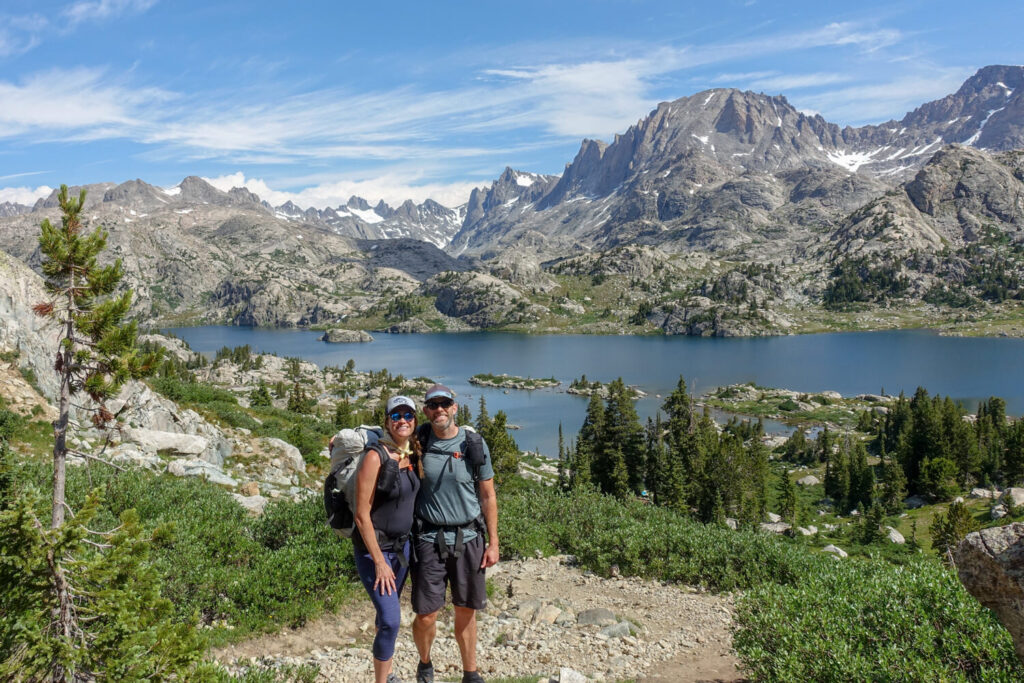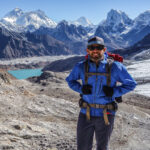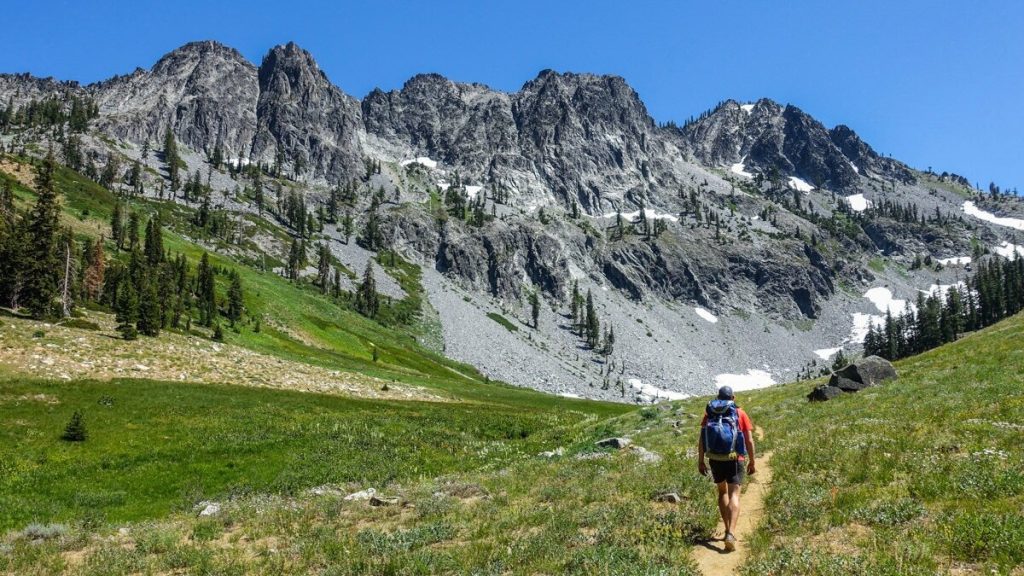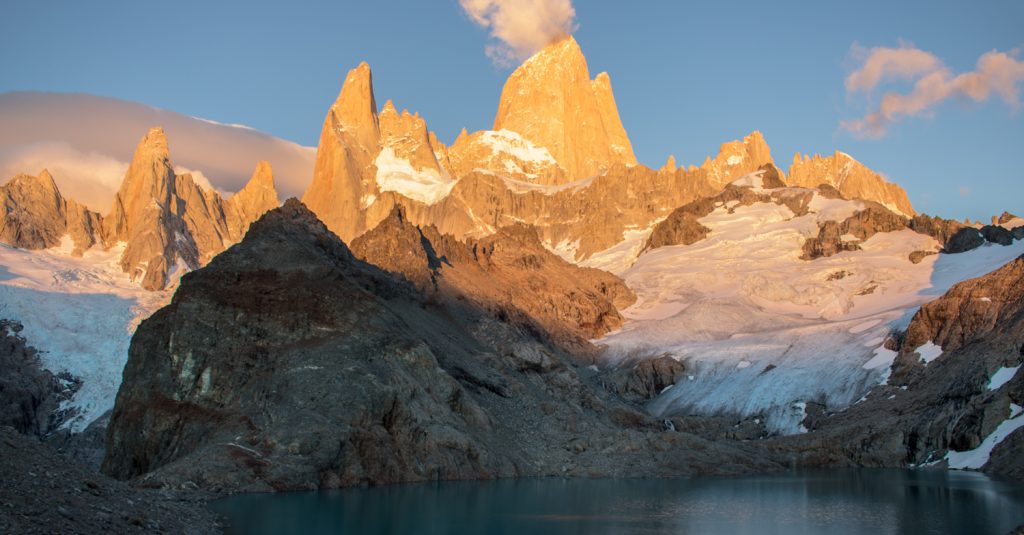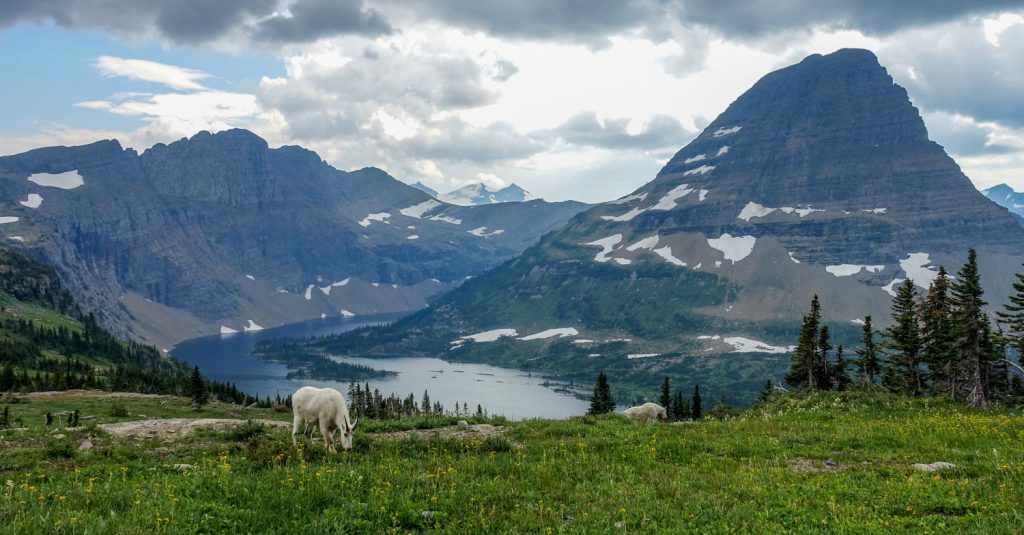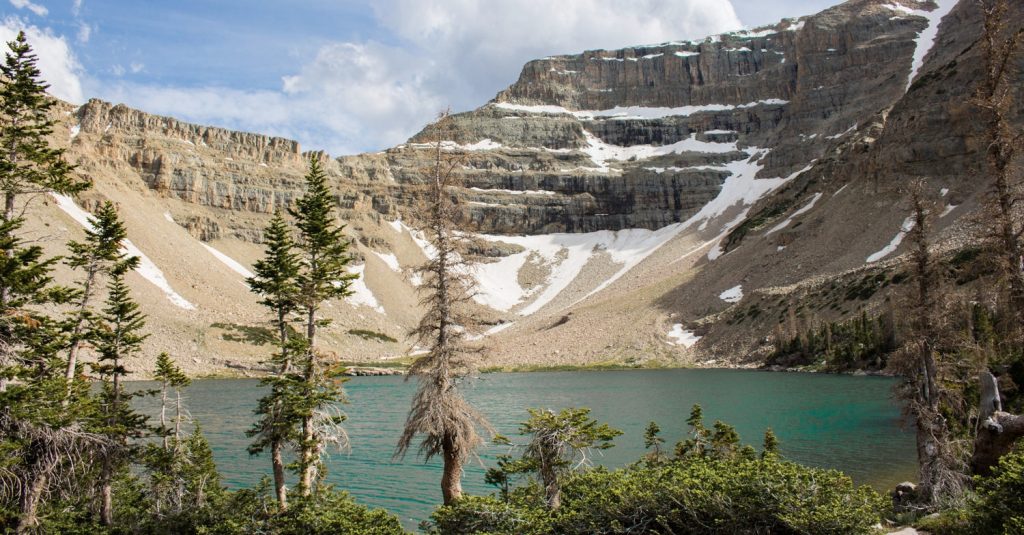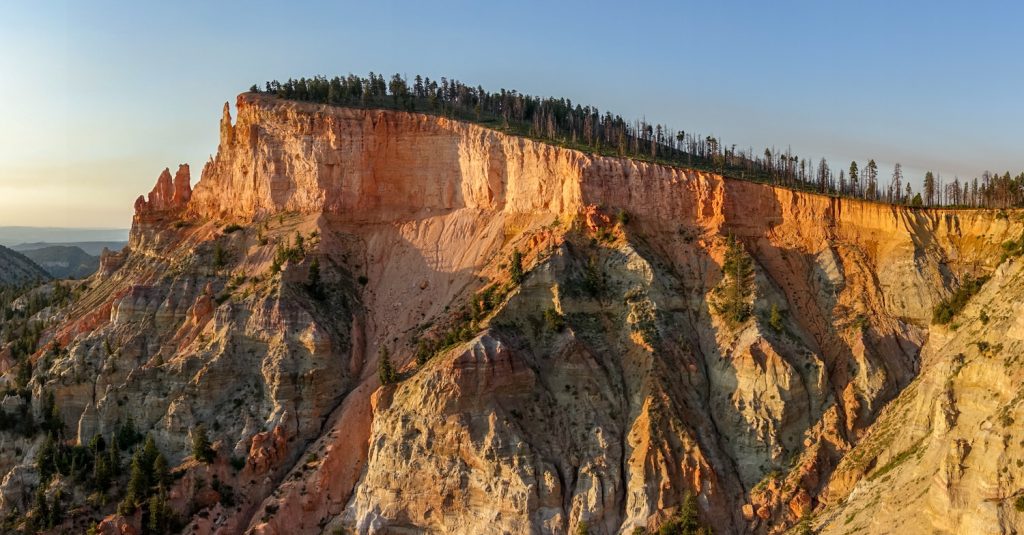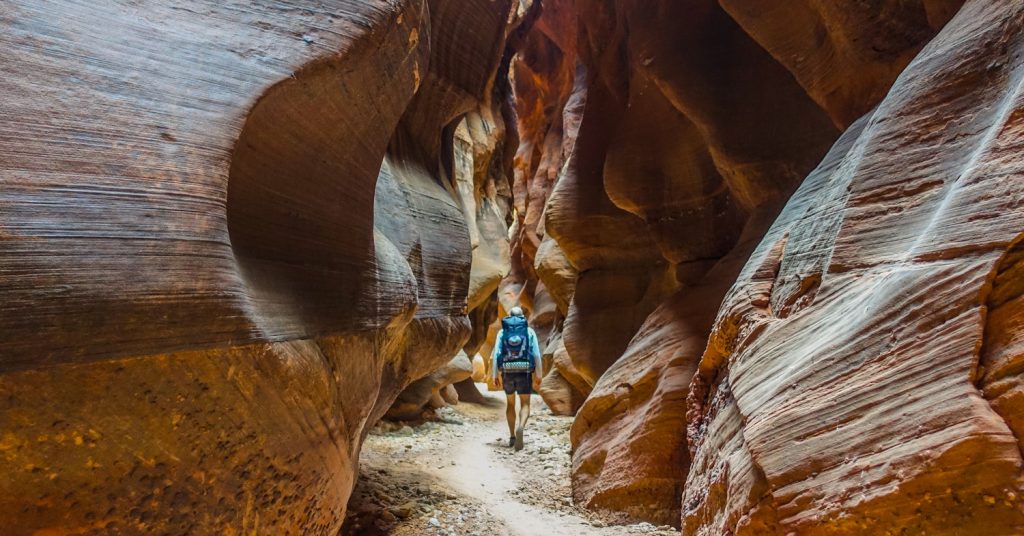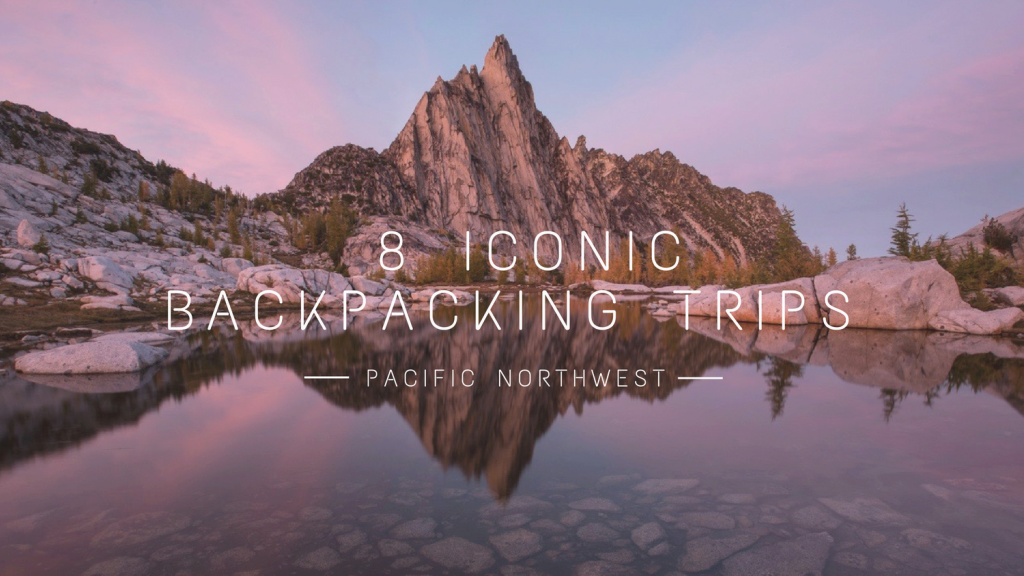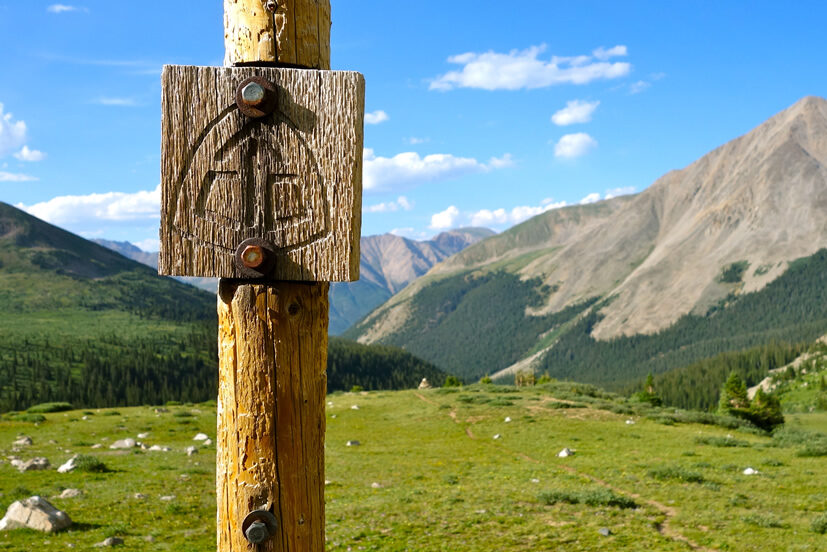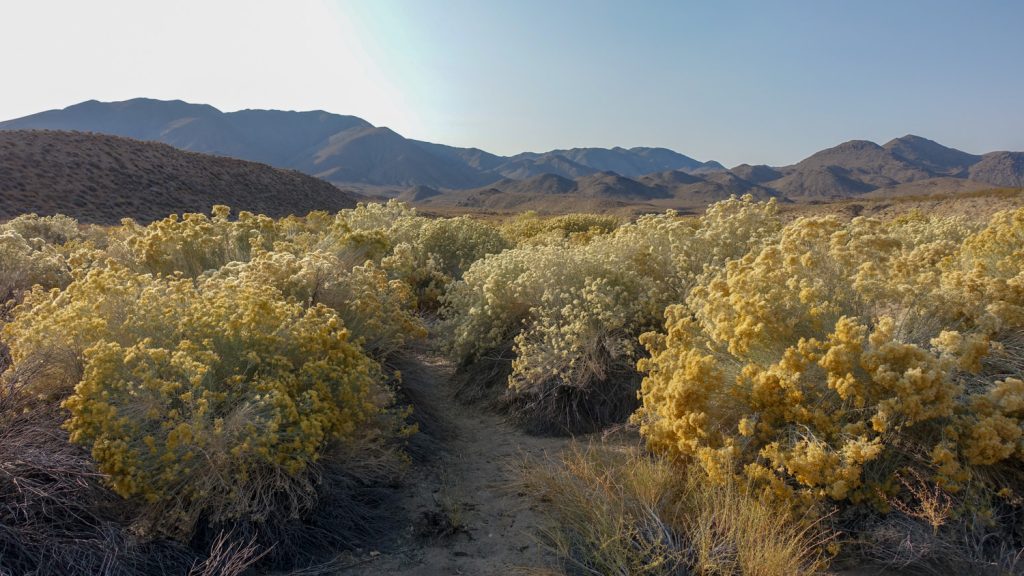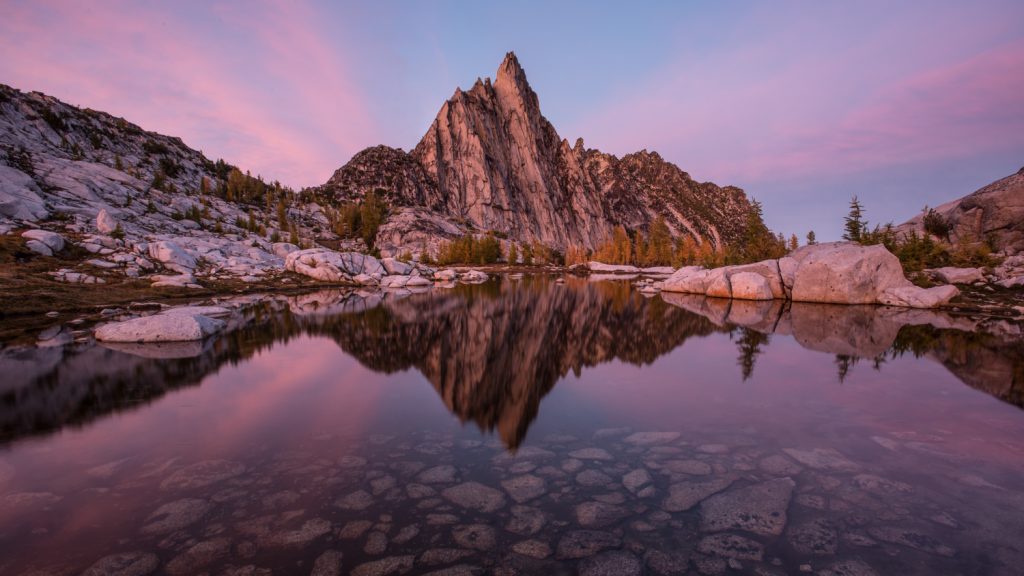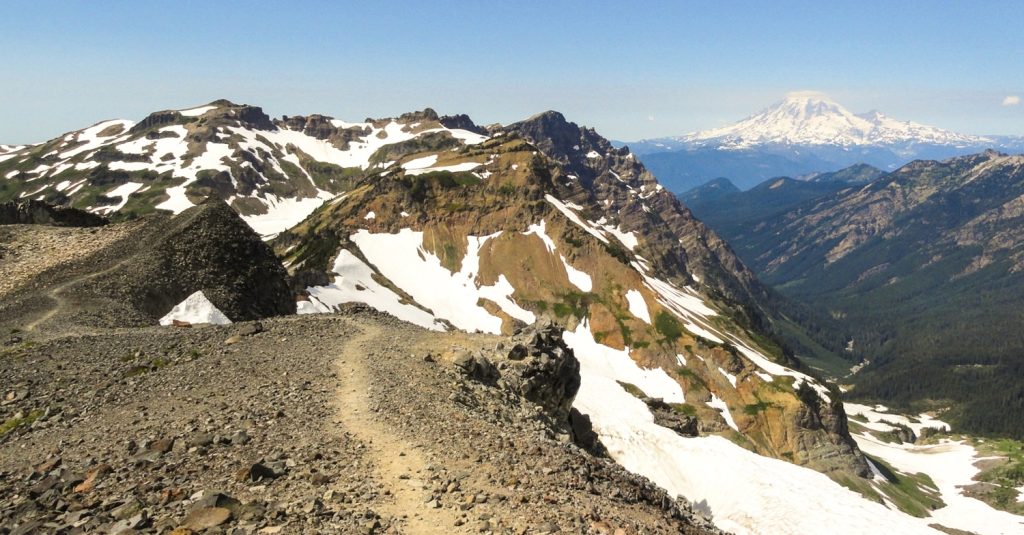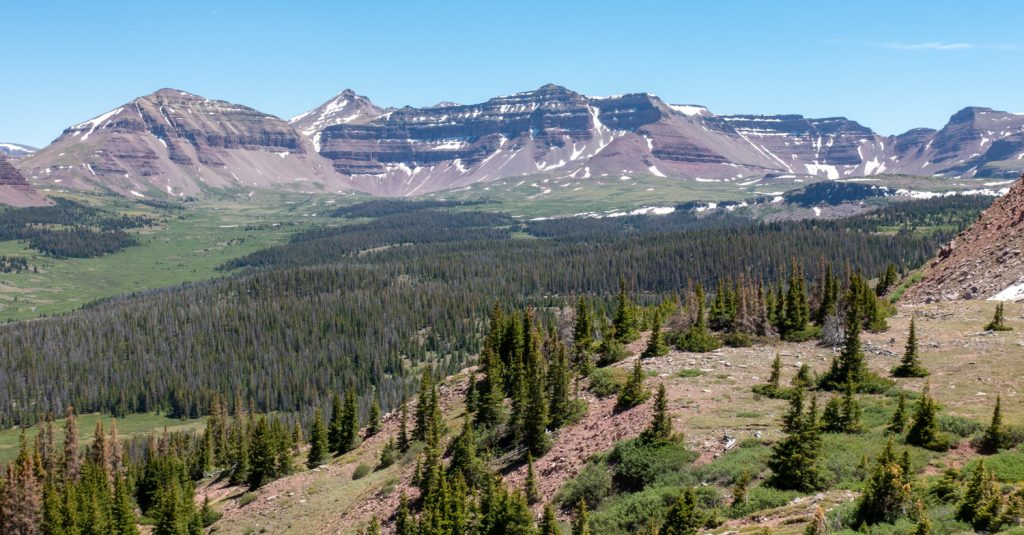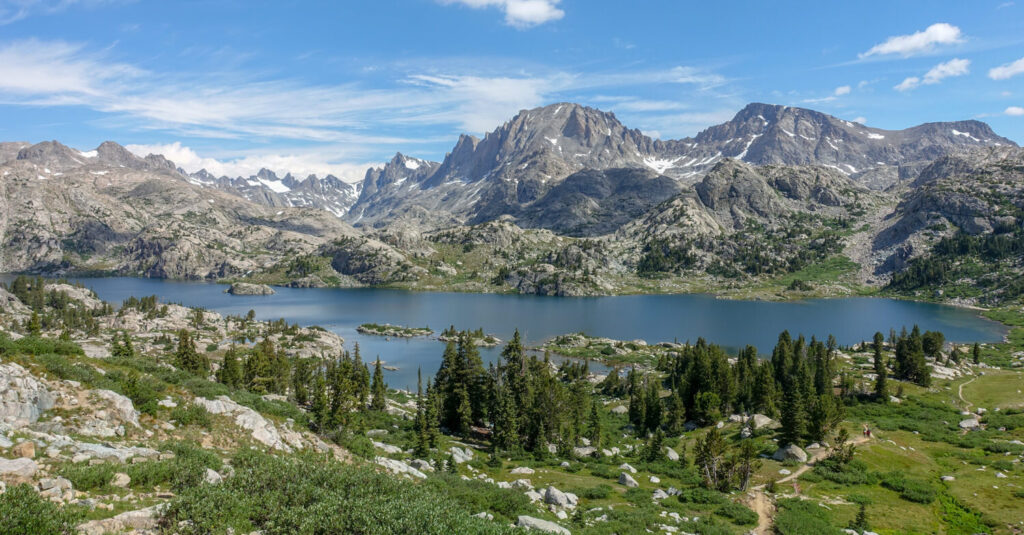
With dense forests, granite slabs, high alpine meadows and lakes cradled beneath craggy granite peaks, The Wind River Range, or The Winds, as they’re called by fans, are jammed with bucket-list day hikes and backpacking trips that reward you with epic views and unbelievable beauty.
The trail out to Titcomb Basin, located deep in the range, is an unforgettable destination surrounded by peaks towering 3,000 feet above the granite slab cirque. Wyoming’s highest peak, the 13,804-foot Gannett Peak, stands like a sentinel among them in this area.
In this guide, we focus on getting out to Titcomb Basin, and circumnavigating the spectacular basin. Just keep in mind when planning that the window is short and that means lots of people trying to get in about the same time. Adjust your expectations for solitude.
Quick Facts
Distance: 30 miles
Days Needed: 3-6 days
Peak Elevation: 10,631 ft. / 3,240 m
Elevation Gain/Loss: 3,409 ft / 1,039 m
Best Travel Time: August to Mid-September
Permits: Required (see below)
Difficulty: Moderate to Difficult
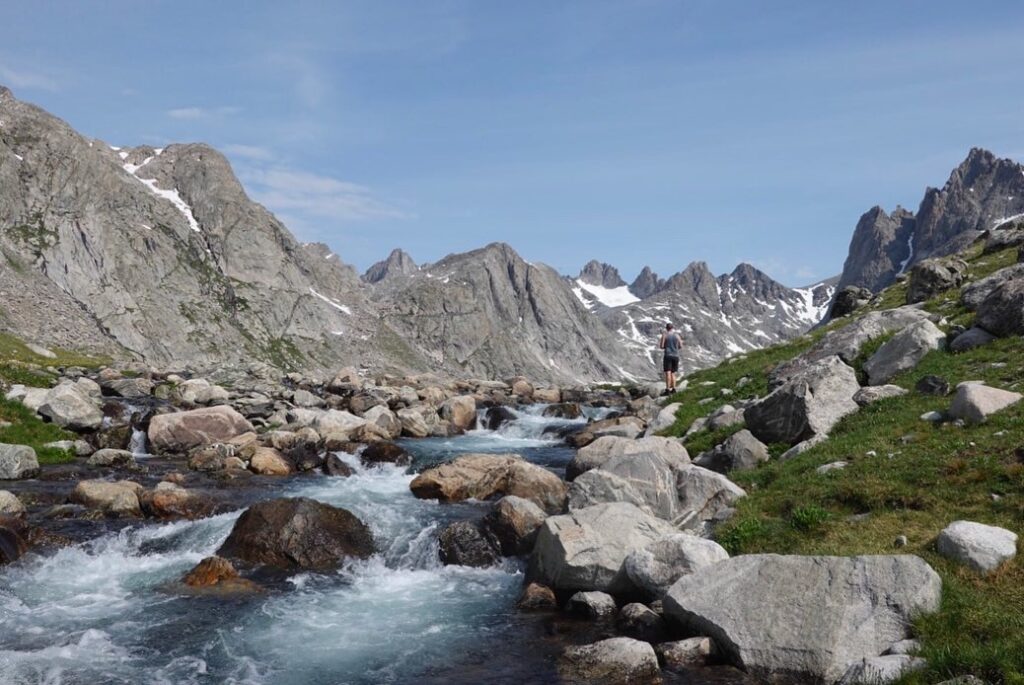
Highlights
- Wildlife galore, including pika, marmot, ground squirrel, chipmunk, beaver, moose, elk, bighorn sheep, gray wolf, mule deer, and grizzly and black bear
- Glacial action left cirques, kettles, U-shaped valleys, hanging troughs
- Good for fishing – many of the lakes hold grayling, mountain whitefish, and trout
- Surrounded by craggy peaks and granite block mountains
- Amazing lighting makes great photos
- Well-maintained trails
- Dogs can travel with you
Lowlights
- Snow well into August at high elevations
- Sudden storms; lightening is not uncommon
- Few trees in the higher elevations
- Early snow in the fall
- Mosquitos, gnats and deer and horseflies are plentiful
- Campsites can be hard to find, either due to crowding or water proximity rules
- Icy cold lakes makes swimming tempting but challenging
- Giardia and campylobacter are prevalent in the streams and lakes
- Lots of people
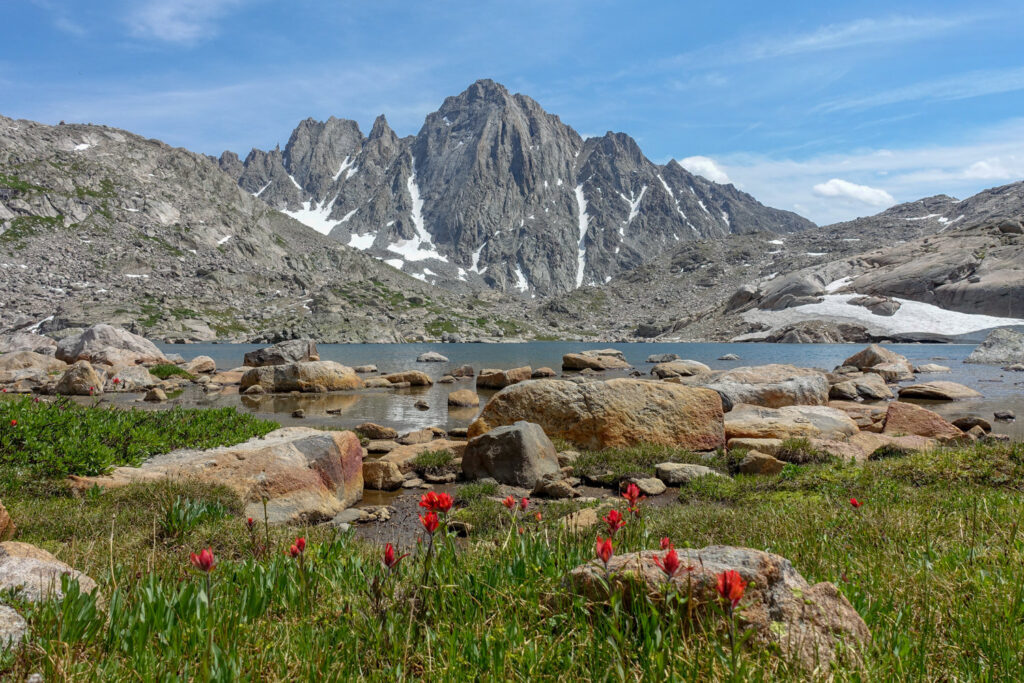
Best Time to Travel
Winter snows generally remain on the high passes and highest trails until mid-July. Some years, you can get on the trails by Mid-June, although you will encounter bugs and snow. Stream flows are high and swift during snowmelt runoff June through July, and some stream crossings can be challenging and dangerous. Late August to early September offer the best weather. Mid-September through late September offers the least bugs and people. Snow normally remains on the high passes and highest trails until mid-July.
Sudden rain and occasional snow flurries may occur at ANY TIME (hikers have been caught in hail and snow storms on the same day in August). Even with highs in the high-70s or low 80s, night temperatures may be as low as 25 degrees at night. Stream typically run high and swift during snowmelt runoff in June and July, and some stream crossings can be hazardous.
Afternoon thunderstorms are common from July through July. And range is called The Winds for a good reason. It can get ferocious. Thunderstorms with lightning are very common in the afternoon. Keep that in mind when hiking out in the open above timberline. Avoid lone trees, open granite slab areas, high meadows, ridges, and mountaintops. Look for dense stands of trees or boulder fields with rocks big enough to wedge yourself under for the duration of the storm. Check at the Pinedale Ranger Station Office, or call them at 307-367-4326, before beginning your trip, or check the National Weather Service.
Difficulty
We rate most backpacking trips in this area as moderate to difficult due to many steep ascents and the elevation. As always, difficulty ratings depend on the route you choose, experience, physical fitness, pack weight, and weather conditions. Although most routes in The Winds are not technically demanding, you should always plan thoroughly, train properly, know your limitations, brush up on your skills, and dial in your gear. Doing so will make for a more safe and enjoyable adventure.
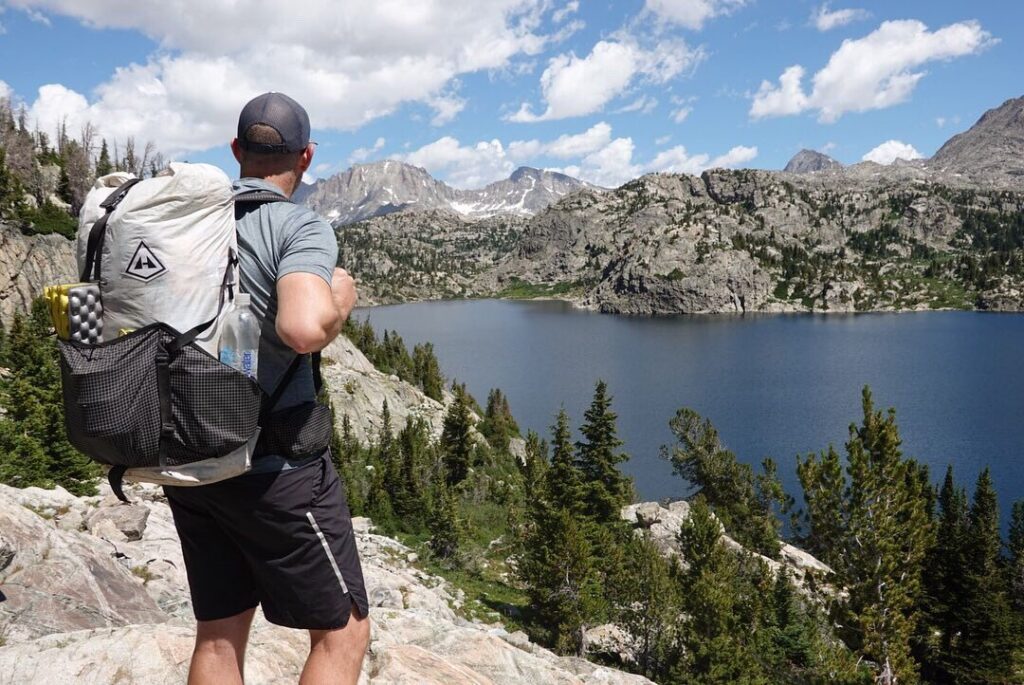
Permits
Permits are not required for most hikers into the Titcomb Basin. Permits are required for organized (clubs, schools, church, scouts, etc.) groups, all parties using pack and saddle stock overnight, and commercial uses (outfitters and guides).
Obtain a permit from the Pinedale Ranger District, PO Box 220, Pinedale, WY 82941, 307-367-4326. There is no charge for these permits as long as the groups are not commercial. You will need to provide the following information:
- Dates of trip
- Location of entrance, exit, and planned campsites
- Number of people in group (15 is maximum)
- Scout groups are also required to send a copy of the Scout Council Tour Permit, in advance of their planned Wilderness trip.
Hunting and Fishing
Hunting and fishing is allowed with a valid Wyoming hunting or fishing license.Order ahead or visit the Wyoming Game and Fish Department, State of Wyoming, Cheyenne Wyoming 82002, or pick up at any appointed licensing agents throughout the state (supply and outdoor stores).
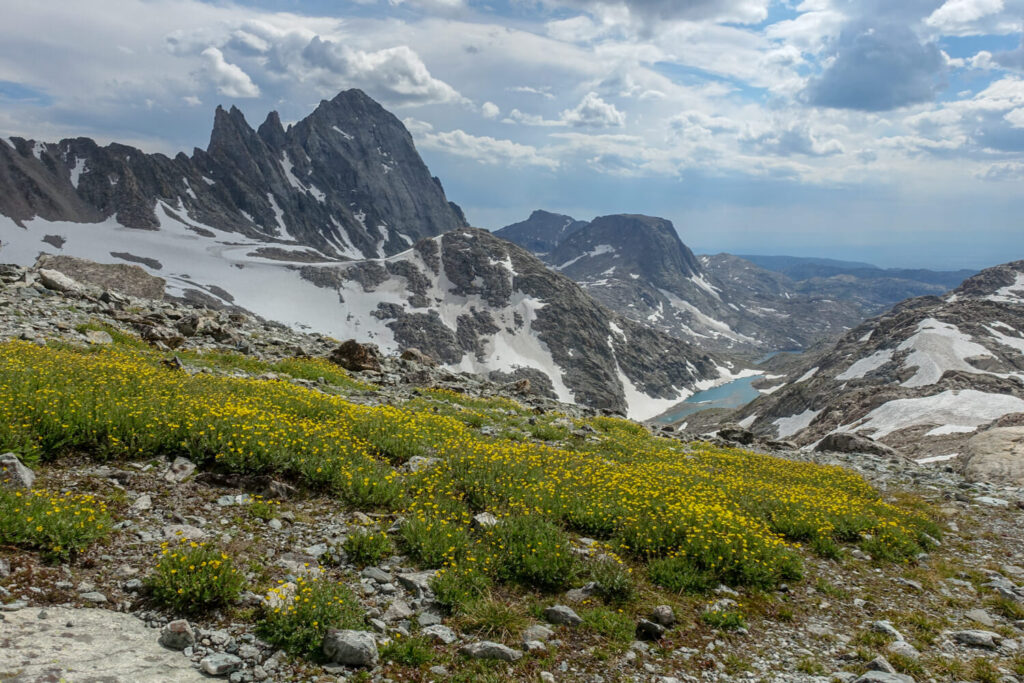
Trailhead Options
Elkhart Park Trailhead – This is a major—highly popular—access point into the Wind River Range. It’s sometimes also referred to as the Pole Creek Trailhead. It’s located 15 miles northeast of Pinedale on a fully paved access road. There’s a very small campground with 8 campsites and toilets, but no drinking water (so fill up before you leave town)—only non-potable water.But there is a manned Forest Service Visitor Center, located at the entrance to Elkhart Park.
Green River Lakes Trailhead– At the northernmost tip of the Wind River Range, the Green River Lakes Trailhead, located at an elevation of 8,000 feet lies 52 miles north of Pinedale over about 21 miles of rough, sometimes rutted gravel and dirt road. The Forest Service operates the Green River Lakes Campground at the trailhead with 39 sites. It’s a high-use area with toilets and potable drinking water.
Green River Lakes Trailhead is one of the lowest trailheads in the Winds. It offers incredible views of Squaretop Mountain, which towers over the sprawling river valley. It’s also the access point to Stroud Glacier and the headwaters of the Green River.
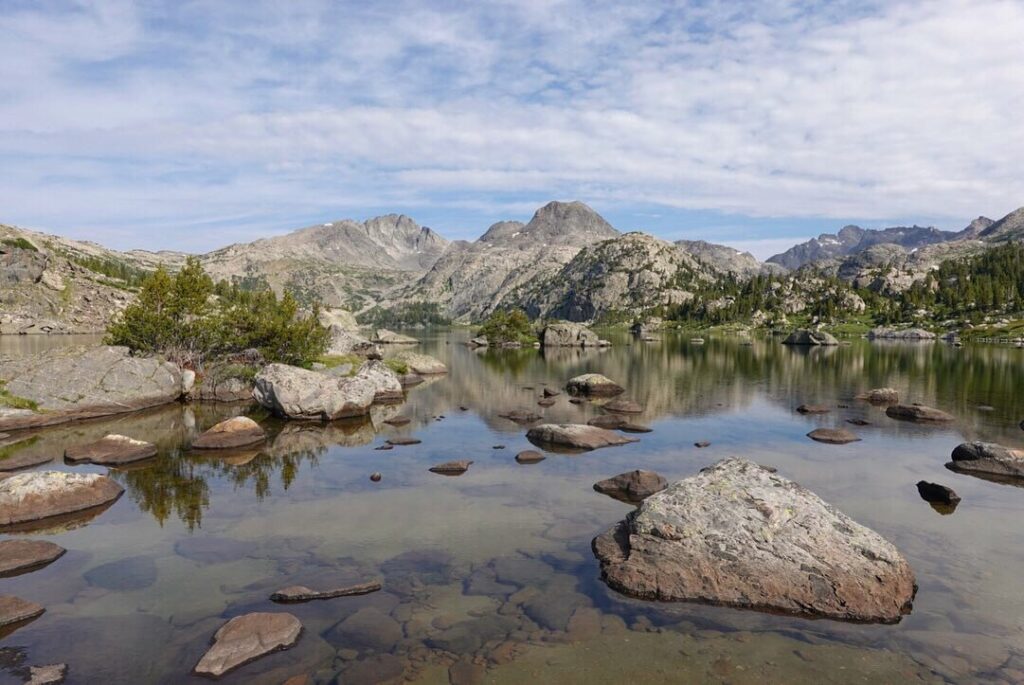
Possible Itineraries
TWO NIGHT OPTIONS
Elkhart Park Trailhead to Titcomb Basin
- Starting Trailhead –Elkhart Park
- Camp 1 – Island Lake
- Camp 2–Day hike to Titcomb Basin, then camp at Seneca Lake
- Ending trailhead – Elkhart Park
Green River Lakes to Summit Lake
- Starting Trailhead – Green River Lakes
- Camp 1 – Trapper Lake
- Camp 2 – Summit Lake with day hike to Elbow Lake
- Ending Trailhead – Green River Lakes
THREE NIGHT OPTIONS
Elkart Park to Titcomb Basin to Cook Lakes
- Starting Trailhead –Elkhart Park
- Camp 1 – Island Lake
- Camp 2 – Island Lake (day hike to Titcomb Basin & Indian Basin)
- Camp 3 – Cook Lakes
- Ending Trailhead – Elkhart Park
Green River Lakes to Lost Lake
- Starting Trailhead –Green River Lakes
- Camp 1 – Trapper Lake
- Camp 2 – Summit Lake
- Camp 3 – Beaver Park
- Ending Trailhead – Green River Lakes
FOUR NIGHT OPTION
Green River Lakes to Titcomb Basin
- Starting Trailhead –Green River Lakes
- Camp 1 – Three Forks Parks
- Camp 2 – Summit Lake (day hike to Titcomb Basin)
- Camp 3 – Summit Lake
- Camp 4 – Trapper Lake
- Ending Trailhead – Green River Lakes
FIVE NIGHT OPTION
Green River Lakes to Titcomb Basin
- Starting Trailhead –Green River Lakes
- Camp 1 – Three Forks Parks
- Camp 2 – Summit Lake
- Camp 3 – Island Lake (day hike to Titcomb Basin)
- Camp 4 – Jean Lakes
- Camp 5 – Three Fork Parks
- Ending Trailhead – Green River Lakes
FIVE NIGHT OPTION WITH SHUTTLE
Green River Lakes to Titcomb Basin to Elkhart Trailhead
- Starting Trailhead –Green River Lakes
- Camp 1 – Trail Creek Park
- Camp 2 – Elbow Lake (side trip to Peak Lake)
- Camp 3 – Indian Basin via Indian Pass
- Camp 5 – Titcomb Lakes or Seneca Lake
- Ending Trailhead – Elkhart Lake (requires shuttle)
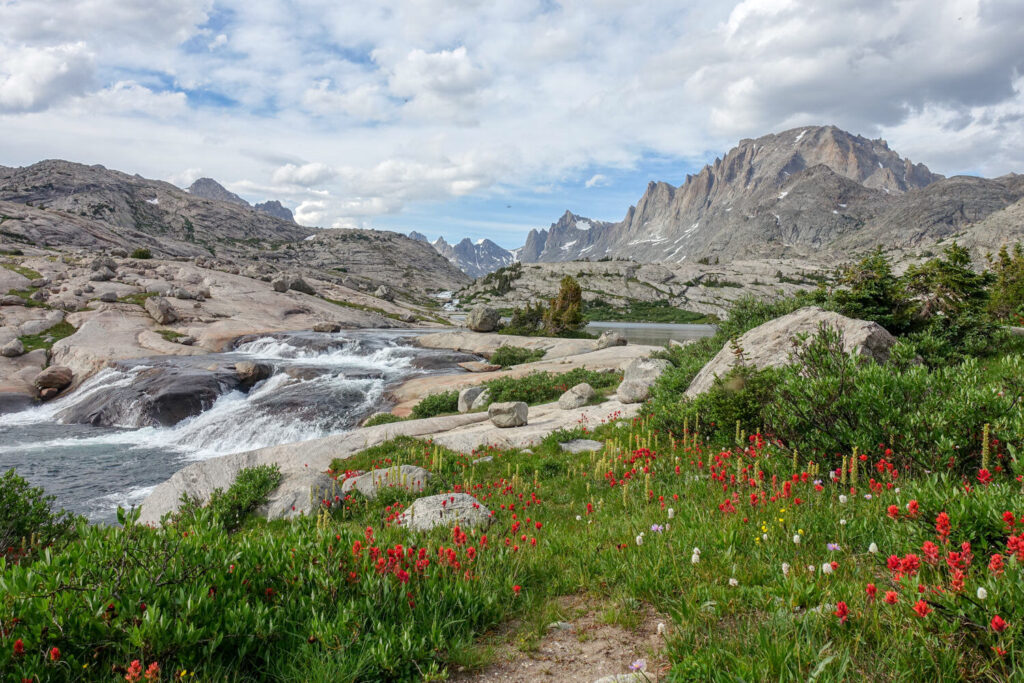
Shuttle Info
The Great Outdoor Transportation Company operates a shuttle to trailheads. Reservations can be made online. Options include:
VEHICLE SHUTTLE
Park your vehicle at the entrance trailhead, sometime during the trip GOTC will pick up your vehicle and drive it to the exit trailhead. Pinedale to Green River Lakes (or visa versa): $120 (vehicle or people shuttle), add $20 for each additional person. Pinedale to Elkhart Park (or visa versa): $40 (vehicle or people shuttle), $5 for each additional person.
PEOPLE SHUTTLE
Park your vehicle at the exit trailhead, and GOTCO picks you up at the designated time and transport you to the entrance trailhead, where you may begin your trip. Pinedale to Green River Lakes (or visa versa): $120 (vehicle or people shuttle), add $20 for each additional person. Pinedale to Elkhart Park (or visa versa): $40 (vehicle or people shuttle), $5 for each additional person.
POINT-TO-POINT SHUTTLE
Get picked up at any designated location (airport, hotel, trailhead, other) and shuttle you to another location (airport, hotel, trailhead, other). Call for prices.
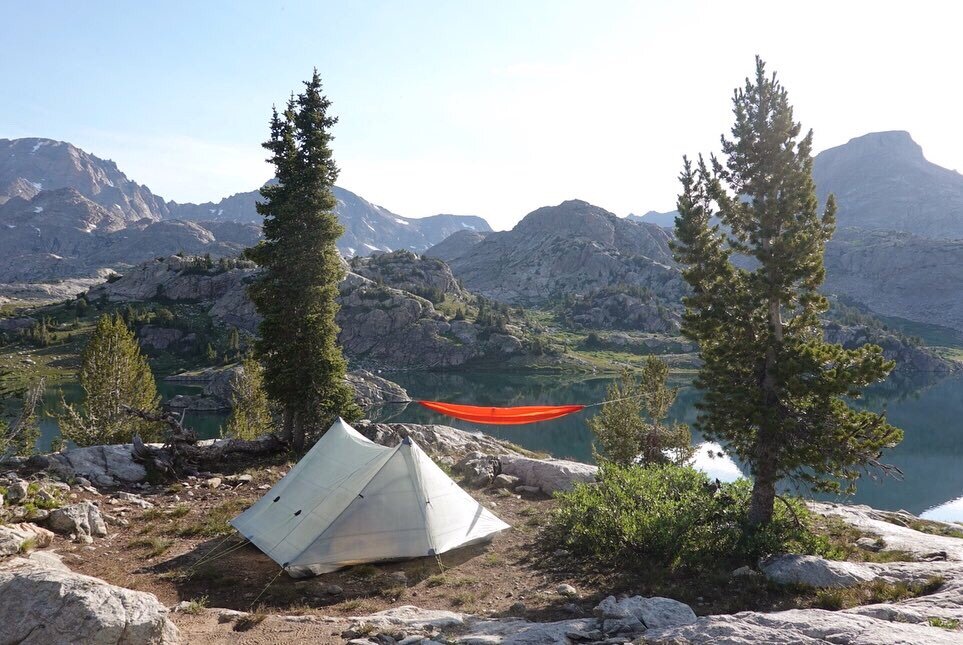
Campsites
All camping is undesignated, but always look for pre-existing sites. Wilderness Rules apply and are enforced by rangers in the area. Look for existing-use sites, 100 ft. from the river, 200 ft. from trail or lakeshore. Also, try to find a campsite away from other people’s campsites not only for yours’ but their privacy and sense of solitude.
Note that the forest between Green River Lakes Trailhead until about Trail Creek Park is dead. Lodgepole pine bark beetle wiped out most of the low elevation forests in the region. Add to that the fact that the river valley limits your options to the riverbank. So finding a legal campsite (100-ft. rule) in this area is difficult. In other areas, granite slabs and talus dominate.
Camping is also difficult to find in Titcomb Basin—most of the sites are illegal. Look near the outlet of Lower Titcomb Lake, as well as slightly above Titcomb Basin at Mistake Lake. If you get lucky and find a suitable legal camp in the basin, make sure your food is properly stored. There are no trees in the basin; you’ll need to wedge your bear canister under a large boulder—out of reach of marauders.
Island Lake is a very popular place to camp. But the camping, fishing, sandy beaches and many incredible mountain views take mean you will be sharing it with a lot of other backpackers. Also campfires are illegal at Island Lake and areas above it.
Surrounded by sheer granite cliffs, Seneca Lake is also a difficult place to find camping, though a small single tent won’t be as difficult to site. Campsites for these can be found at the lake inlet or on the southwest corner of the lake. Groups will have a much harder time finding a place to pitch multiple tents.
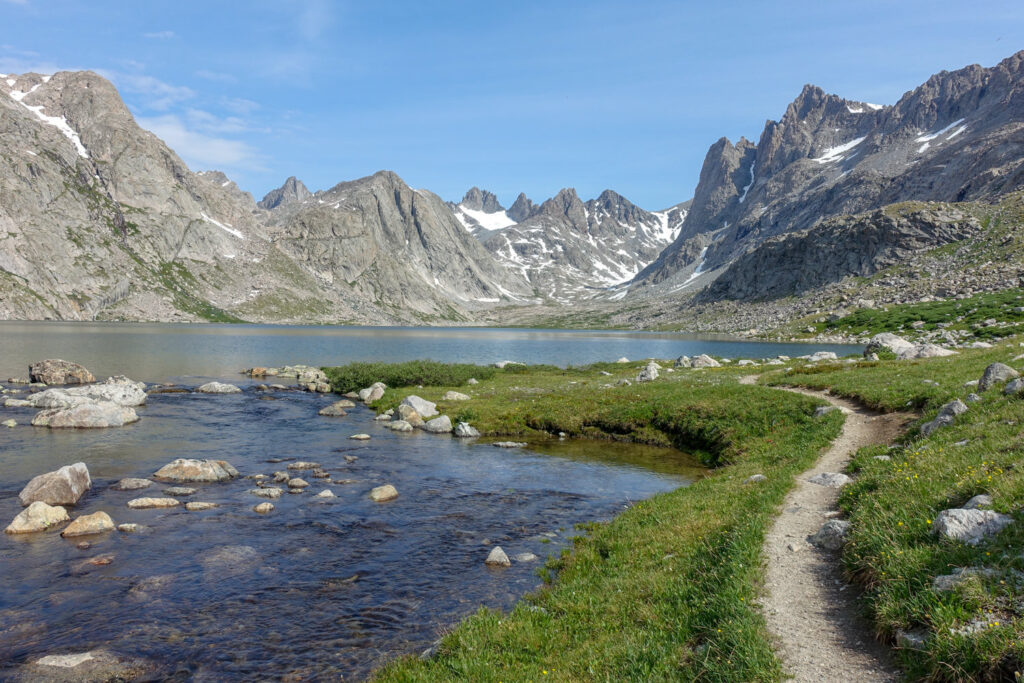
Maps & Guidebooks
- Beartooth Publishing Wind River Range Map– All trailheads and access roads are shown to get your trip started. Scaled to 1:100,000 with contours at 100 ft. 2017 ed. Get this for planning purposes, since the USFS is no longer issuing their wilderness maps of this area.
- Earthwalk Press North Wind River Range – Wind River Topographic Map, from Elkhart Park to Union Pass. It is the equivalent of 18 7.5-minute USGS quadrangles. Scaled to 1:48000. Planning trips information and backcountry regulations are included. Printed on waterproof and tear resistant material.
- Hiking Wyoming’s Wind River Range – This book offers excellent trail descriptions and includes a mileage log and elevation chart.
- Beyond Trails in The Wind River Mountains of Wyoming by Nancy Palliser. This unbelievably thorough and comprehensive guide is designed primarily for advanced hikers with some climbing and glacier travel skills, although it also includes some easy routes. The maps are on an included CD-ROM, which also includes photos, pass routes, high-quality topos with overlayed use-trails, and virtual tours. This is an
- Climbing and Hiking the Wind River Mountains by Joe Kelsey. The trail descriptions are brief, but it offers very good trail diagrams. It also describes some off-trail routes, including Class 2 scrambles.
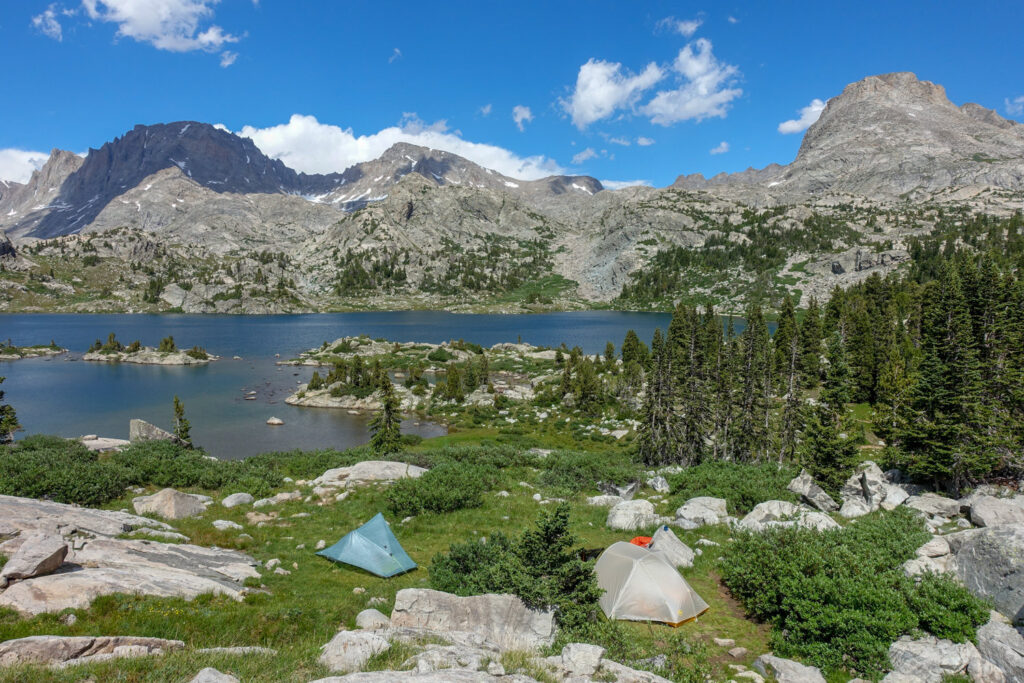
Water
Water is abundant along the trail, except just above upper Green River Lake and Elbow Creek below Beaver Park. The water is incredibly silty from glacial runoff most of the year in these locations.
In other places along the trail, water in the Bridger Wilderness looks incredibly pure. Due to all the animals roaming around it, it’s not. The parasite Giardia, an ever-present organism in the feces of infected animals and humans, and is commonly spread through water. Other microbes, including campylobacter, which can upset the stomach and irritate the intestinal tract, also are present.
- Giardia: filter with a pore size less than one half micron.
- Campylobacter: requires boiling for five minutes or filtering.
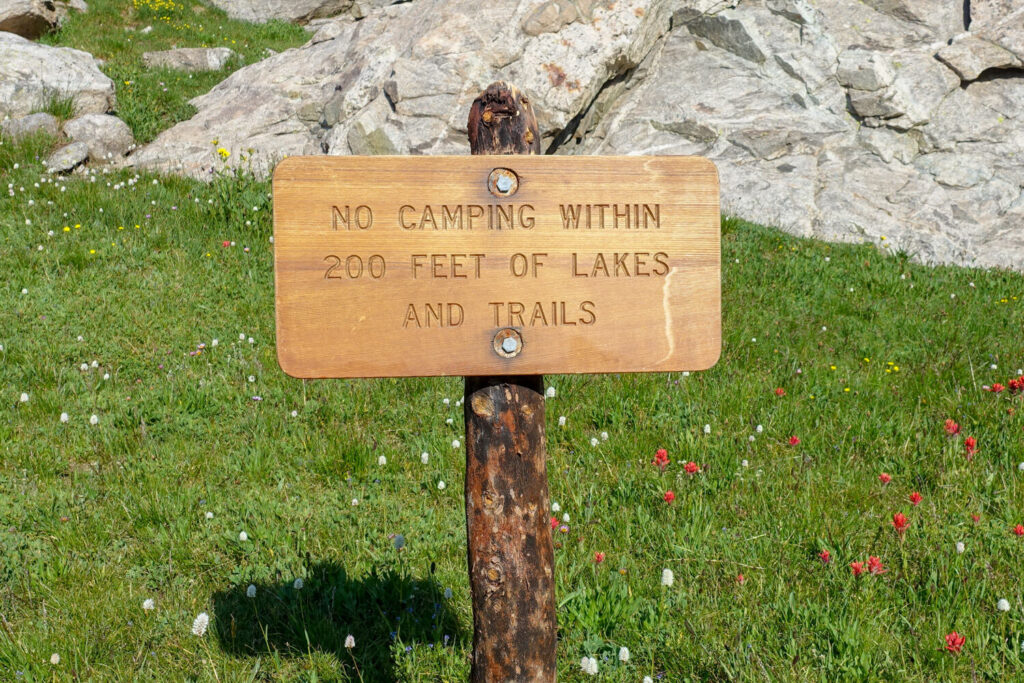
Regulations
This area falls within the Bridge Wilderness Area. The following hiking and backpacking-related activities are prohibited within the Bridger Wilderness:
- Camping within 200 feet of a trail or lakeshore.
- Open campfires within the seven special management areas.
- Horse grazing within 200 feet of lakes.
- Placing or maintaining a cache in the wilderness.
- Cutting or otherwise damaging any live tree or other vegetation without a permit.
- Staying in one campsite for more than 16 days. Visitors who vacate a campsite after 16 days may not return to the same site for at least 5 days.
- Party size is restricted to 15 people.
- Non-burnable garbage must be packed out, not buried.
- Camp structures such as hitch racks, tent frames, pegs and fire rings must be dismantled after use.
- Bury human waste in a shallow hole at least 100 feet from any water supply, so that rain or snow runoff will not carry contaminants into lakes and streams. Body waste decomposes fastest in holes dug 6-8 inches deep.
- Soap (even biodegradable brands) and food particles pollute lakes and streams. Do not wash your dishes, clothes and yourself near the shore of lakes, ponds or streams.
- Carry out cans, bottles, plastics, aluminum foil and anything else that will not burn. Burying won’t work. Frost action will likely push your buried garbage to the surface, or animals will dig it up.
- Keep your dog under your control at all times and away from other people and wildlife.
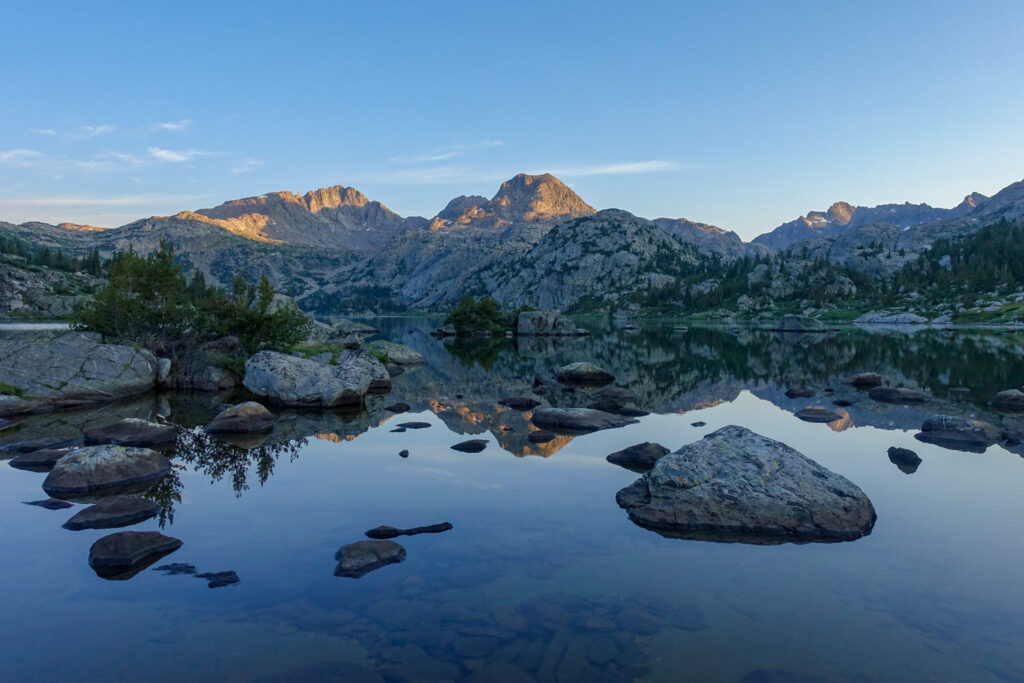
Campfire Regulations
If you can get by without a campfire, do so. Lightweight gas stoves are more efficient and faster for cooking than fires, and they leave no impact. Campfires destroy organic matter in the topsoil and may inhibit plant growth for many years. Blackened rocks, charred wood, and accumulated ash also alter the natural appearance of the site.
If a campfire is used, here are suggestions to minimize impact:
- Burn dead and down wood and only what you need. Standing dead and gnarled snags are components of the wilderness scenery and important habitat for cavity-nesting birds and many small mammals.
- A ring of rocks is unnecessary. Instead, dig a firepit about six inches deep, keep the sod intact and pile it nearby.
- On breaking camp, permit the fire to burn down to white ash and drown the coals thoroughly. If there is buildup of ash, remove it from the firepit and scatter it well away from camp, where people won’t walk through it, and the rain and snow will wash it away.
- Replace the sod and pour water on it.
- Scatter any unused firewood in natural appearing locations.
- Keep your fire small to reduce impact and the danger of forest fire.
- Select a spot a safe distance from trees, brush, and down logs,
- Leave no fire rings. Leave no trace.
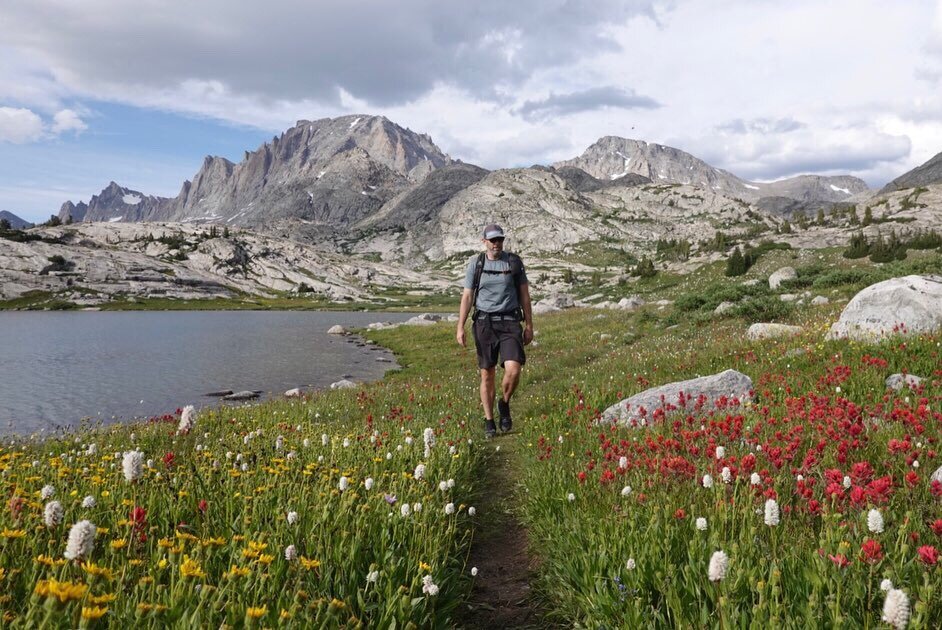
Bears & Food Storage
There are bears in the Wind River Range, both grizzly bears and black bears. So protection and food storage are critical. Because this loop is in such a popular area, it’s highly unlikely that you will encounter any bears along your trip. Still, take the correct precautions just in case.
We carried bear spray when hiking in the Winds because there are grizzly bears in the area. We knew it was highly unlikely that we would see any, but if we did, we wanted to be prepared to protect ourselves. We consider bear spray an essential item when hiking in grizzly country. It could easily save your life in the rare event of an attack.
Food storage is another important consideration. Bear resistant food storage containers are mandatory in the Pinedale Ranger District north of Boulder Creek and outside of the Bridger Wilderness, and are highly recommended elsewhere in The Winds. They are available on loan from the Pinedale District office.
Make sure you know how to hang a bear bag properly or carry a food storage container. Bear canisters and Ursacks are the most effective storage methods and the easiest to use.
Bugs
Mosquitoes, deerflies and horseflies are plentiful from mid-June to early-September, making insect repellent and, perhaps, even a hat with netting, a must. We recommend spraying your clothing with permethrin, as well as bringing plenty of Picaradin. If you’re heading in to the Titcomb Basin when skeeters are at their peak, you may even consider packing in a Thermacell Backpacker Mosquito Repeller, which screws onto a standard fuel canister and works very well.
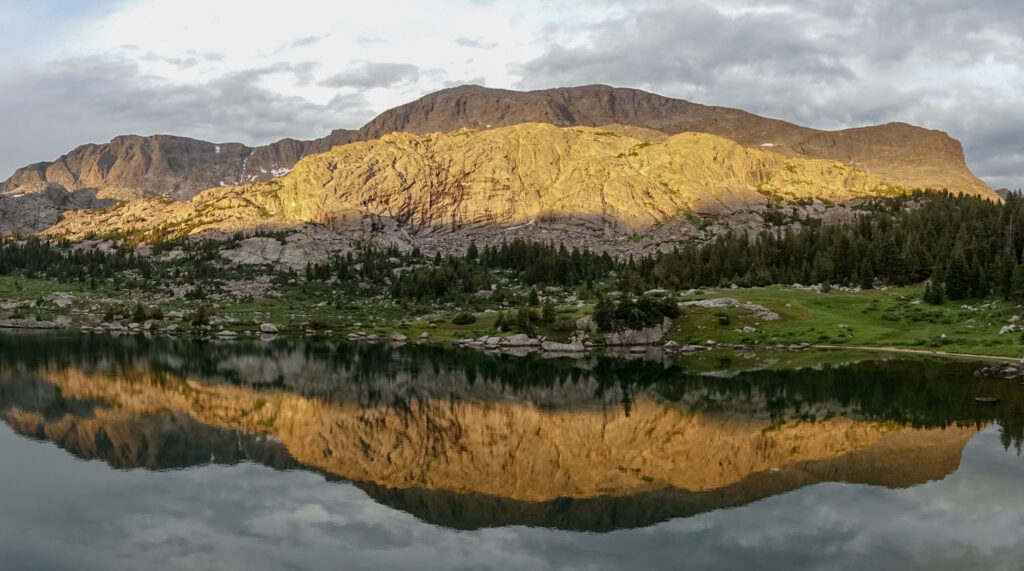
Backpacking Gear
We prefer lightweight backpacking because it’s more comfortable and it allows us to cover more ground with less effort. For recommendations on our favorite lightweight backpacking equipment, check out the CleverHiker Gear Guide and Top Picks page.
WHAT TO PACK
TENT
We used the Zpacks Triplex tent on this trip. We love its combination of incredibly low weight and livability and that’s why it’s one of our top picks on our best lightweight backpacking tents list.
BACKPACK
We used Hyperlite Mountain Gear Southwest 2400 backpacks on this hike. They’re lightweight, convenient, comfortable, and make our list of the best lightweight backpacking packs.
SLEEPING BAG
We used the REI Co-Op Magma Trail Quilt 30° and the Western Mountaineering Alpinlite 20° on this backpacking trip. They are both lightweight, warm, and make our list of the best backpacking sleeping bags.
SLEEPING PAD
We used Therm-a-Rest’s NeoAir UberLite and the NEMO Tensor Insulated sleeping pads on this trip. They’re both light, comfortable, and make our list of the best backpacking sleeping pads.
COOKING SYSTEM
We used the BRS Stove, Snow Peak Mini Solo Cookset, and Snow Peak Folding Spoon on this trek, all of which make our top picks gear list and best lightweight stove list.
WATER PURIFIER
We used the SteriPEN Ultra as our main purification method on this trip. It’s lightweight, works fast, and doesn’t require any pumping/squeezing or chemicals. Check out our best water purifiers list for our other top recommendations.
SHOES OR BOOTS
We wore Saucony Peregrine ISO trail runners (men’s and women’s) on this trail and they were excellent. For more recommendations, check out our Best Hiking Shoes & Boots post. If you prefer boots, make sure they’re lightweight and break them in really well before your trip. Here’s why we prefer hiking in trail running shoes: 5 Reasons to Ditch Your Hiking Boots.
HEADLAMP
A small headlamp like the Petzl Actik CORE or the Black Diamond Spot 325 are affordable, bright, and lightweight options.
FOOD
When backpacking in the Wind River Range you’ll have to carry all your food. Check out ourBest Lightweight Backpacking Food Guide and ourBest Freeze Dried Backpacking Meals for some of our go-to recommendations.
FOOD STORAGE
For this trip, we brought an Ursack for food storage. Make sure you know how to hang a bear bag properly or carry a food storage container. Bear canisters and Ursacks are the most effective storage methods and the easiest to use.
BEAR SPRAY
The Wind River Range is home to a healthy grizzly and black bear population. You should always hike with bear spray and know how to use it properly.
CLOTHING
Here are some of our favorite hiking/backpacking clothing items from ourTop Gear list.
- 1 Rain jacket: Patagonia Storm Racer & Patagonia Stretch Rainshadow
- 1 Down jacket: MontBell Plasma 1000 Alpine Down Parka
- 1 Pair hiking pants: PrAna Zion Stretch & Prana Halle Hiking Pants
- 1 Pair hiking shorts: Nike dri fit running shorts
- 1 Hiking t-shirt: Nike dri fit t-shirt
- 1 Long-sleeve shirt: Nike dri fit quarter zip
- 1 Pair underwear: ExOfficio Give-N-Go & ExOfficio Give-N-Go Women’s Briefs
- 2-3 Pair socks (add thin sock liners if using boots): Balega Hidden Comfort for warm weather & Darn Tough Micro Crew Cushion for cold weather
- 1 Pair base layer bottoms (optional): Patagonia Capilene Air Base Layer Bottoms
- 1 Warm hat
- 1 Sun hat
- 1 Pair gloves or mittens
MAP & COMPASS
We hiked with the Wind River Range North Map and used the Hiking Wyoming’s Wind River Range book for pre-trip planning. In addition, we always hike with a compass.
FIRST AID KIT
Always bring a small personalized first aid kit. We used the .5 Ultralight Kit and added extras, like painkillers and personal medications.
SUN PROTECTION
Sunglasses (polarized recommended), sunscreen, and spf lip balm are an absolute must.
POCKET KNIFE
We brought along a small Swiss Army Knife, which came in handy here and there.
OTHER ITEMS:
- Small towel: the Nano pack towel is great.
- Cash and ID
- Permits
- Personal toiletries
- Hand sanitizer: Always apply after using a bathroom and before eating.
- Wet wipes: These can be useful for cleaning up after hiking.
- Insect repellant: We recommend spraying your clothing with permethrin and also bringing along a 1oz bottle ofPicaridin.
- Camera: theSony Rx100 is our go-to camera for lightweight backpacking.
